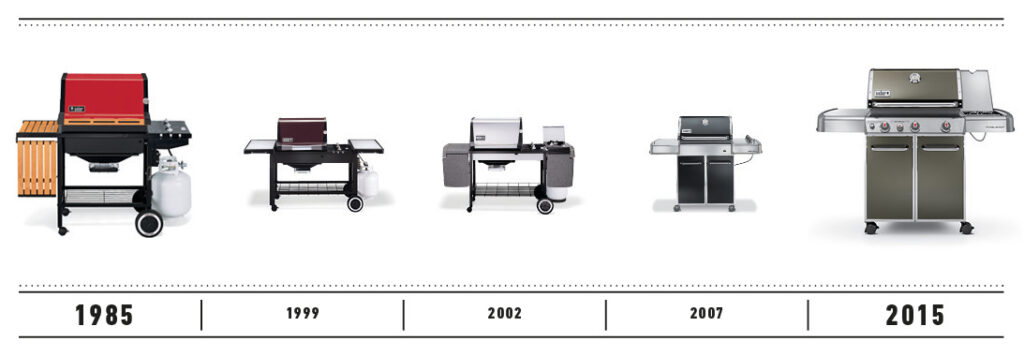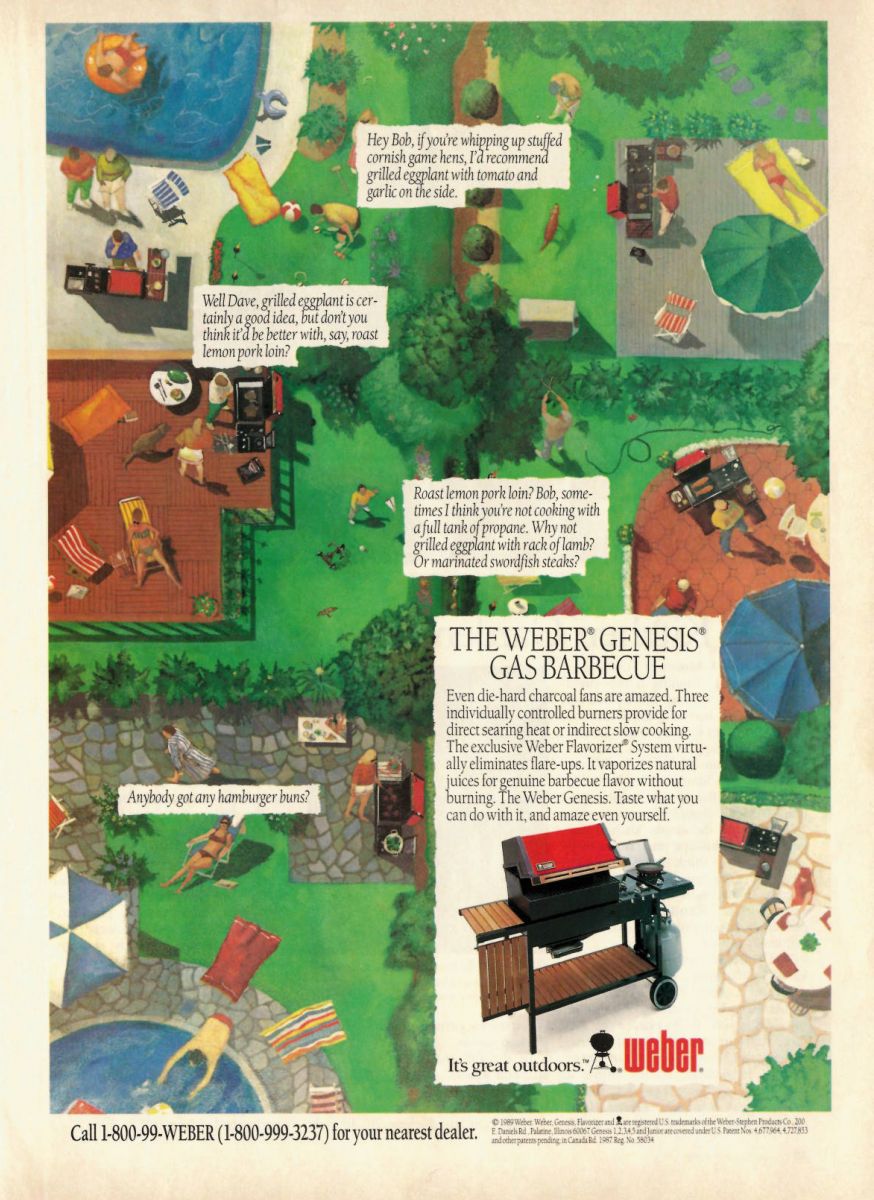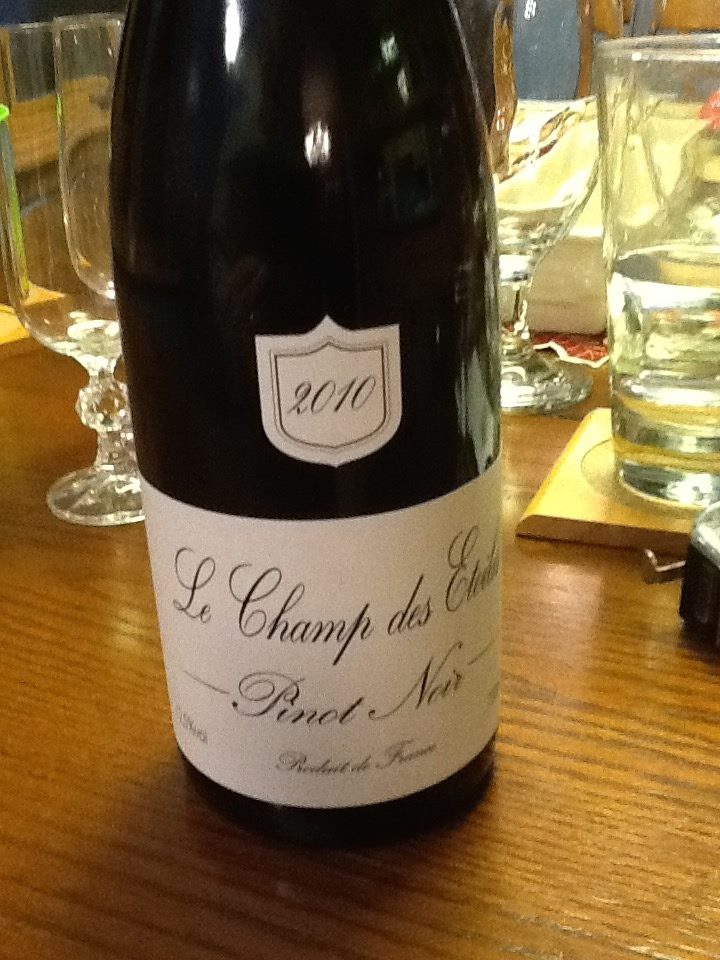- Ready to Bake
- Just Off The Grill
We used up the last of this batch of dough to do another Lou Malnati style deep dish pizza for Friday night.
I’ve adapted the recipe from this one, which was on an episode of Throwdown.
We used up the last of this batch of dough to do another Lou Malnati style deep dish pizza for Friday night.
I’ve adapted the recipe from this one, which was on an episode of Throwdown.
I ran across this recipe idea in The Wall Street Journal last week, and as it happened my wife had just brought home a couple eggplants.
I split the eggplants in two, lengthwise, scored the skins and put them on the grill over medium burners for 15 to 20 minutes, turning occasionally, after hitting them with a little olive oil spray and kosher salt. Also charred a red pepper at the same time.
Then I sautéed a chopped red onion and several cloves of garlic, diced the roasted pepper and added it. After a few minutes I poured in some white wine vinegar, then added the can of (drained) chickpeas and a tablespoon or so of curry powder. Once everything was combined and heated, I spooned it over the Eggplant halves, topped with a little chipped cilantro, hit it with olive oil and salt again, and then put it all back on the grill in a foil pan to finish. Mrs. Noe cooked the quinoa on the stovetop.
This turned out really delicious, and was a nice departure from our usual fare. It’s also prompted me to review an old cookbook titled Curries Without Worries that my wife gave me years ago and I’ve never cooked from. I think that a lot of the recipes seemed too intricate and intimidating when I was younger. Hoping that I’ve grown as a cook since then and can find some treasures in its pages.
I’ve learned a lot since originally posting about how to make pizza on the grill. I think I finally have a foolproof process that can consistently turn out great pies.
One of the most labor intensive parts of the process, for me, has been rolling out and stretching the dough. This time around, I put each dough ball between two sheets of parchment paper and rolled it out with a french pin. For three crusts, this probably saved me half-an-hour’s work.
The second tricky part of my old process was getting the dough on to the grill. The double parchment made this easy too. I simply placed the dough, paper and all, on a preheated plancha (with the grill at about 500 F), thus avoiding the treacherous “commit and flip” ritual. After a minute or so, I used a spatula to flip the dough, and one sheet of the paper came right off. I sprayed the dough with olive oil at this point, and after another minute flipped again, removed the other paper and sprayed that side as well. Then it was a simple matter of turning the dough occasionally as it baked, until one side had been grilled for three to four minutes and the other side for two to three.
At that point, we topped the side that had been cooked longest, and put the pizza back on the plancha for another two or three minutes to finish. If we had been using toppings that required more thorough cooking (sausage or whatever) we would have par-cooked those in a pan ahead of time.
This process was a lot less hassle than what I was doing before, and it avoided the problem of the crusts getting a little too charred from being directly over the flames.
I used a cast iron plancha on the Weber Genesis, but if you’re cooking over charcoal, you could use any heavy pan or a pizza stone. Just be sure to get everything up to a high temperature before you start cooking.
Do you cook pizza outdoors? I’d love to hear about your recipes and process. Leave a note in the comments.
For several months now, my father-in-law has been casually asking “If I brought some Walleye over, would you fix it on the grill?” I’d always say that I would, but was more or less dreading it. I like walleye breaded and fried, but have never been nuts about the texture or flavor of it prepared otherwise. I’ve also had no experience cooking that sort of fish on the grill.
I do love my in-laws, though, and finding ways to delight them with a meal is always a pleasure. So I began looking for recipes and techniques that would turn out something satisfying.
The walleye arrived as bags of frozen fillets. I thawed several bags and put the fish into a bowl of salt water for awhile. After reviewing a bunch of recipes online, I decided that the best approach would be to season the walleye with my barbecue rub, hit it with some canola oil and bake it indirect on the Genesis in foil pans. I also sprinkled it with Herbs de Provence and lime juice toward the end of the cook (which was about 15 to 20 minutes).
It wasn’t bad. I think I got the cook time right. I’d be tempted next time to marinate the fillets in either citrus or some sort of strong brine overnight. I might also roll them in cornmeal or breadcrumbs.
Dad seem to enjoy them, and that’s the main thing. He was a fairly serious fisherman in his younger days, and I think he misses it. He also doesn’t grill anymore, and I think he misses that too. Claudia has told me of the times when he would have a smoker going for fish or game, just outside her bedroom window when she was a kid.
We served the fish with a delicious zucchini and yellow squash casserole that Claudia made, Wulff Salad, roasted cauliflower wedges that I did on the Genesis (with herbs, mustard powder and cheese), and some nice bread that I baked earlier in the day. The wine was an A to Z Pinto Gris, which was tasty, though a little sweet for my palate.
For Sunday Dinner this week, I tried a recipe from Weber’s Big Book of Grilling, which is one of their older publications. I picked up a copy used for $3 after a friend of mine had posted shots of dry rubbed ribs he’d made using a recipe from the book.
The recipe noted that if you grew up on Sloppy Joes as ground beef and something from a packet, you deserve better.
This was pretty amazing. It called for a (fairly typical) dry rub on a three pound chuck roast, which you then sear for fifteen minutes and cook indirect for an hour or so. The sauce starts with a red bell pepper, a red onion and some garlic. Then you add a little chili powder and flour to make a sort of roux, then add beef stock, canned tomatoes and barbecue sauce. When the roast is done, you carve it into small bits and let it simmer in the sauce for half-an-hour or so.
The result is something with a similar flavor profile to what you may remember from childhood, but much richer and with much more texture. Though it was a fairly labor intensive, it was well worth the effort.
We served this with potato wedges (coated with olive oil and a packet of ranch dressing seasoning, then baked on the grill while the beef was simmering) and a nice green salad.
Lucky for you, if you’d like to try the recipe, it’s online here.
For Sunday Dinner last week, I decided to make an old fashioned meal like my mama would have made, except I cooked it on the Weber Genesis.
I used this BBQ Meatloaf recipe from Larry Donahue at Weber’s website, and Mike Lang’s recipe for twice baked potatoes on a plank from Another Pint Please.
We also had my wife’s famous Wulff Salad, and I roasted some brussels sprouts.
Everything turned out delicious, though I think I’d season the potatoes a bit more next time. It wasn’t the fault of Mike’s recipe. I just went lighter than I should.
This is definitely a meal we’ll have again, though.
We had lovely weather on Easter Sunday this year, perfect for cooking on the Weber Genesis.
Mrs. Noe made a incredible twice baked potato casserole and her delicious Yorkshire Pudding popovers. She and her mom put together another beautiful salad with Wulff family vinaigrette, and I cooked a glazed ham and some asparagus on the patio.
Here’s the recipe for the glaze.
Since the ham was 14 pounds (instead of the ten in the recipe) I decided to double the ingredients for the glaze. We also didn’t have molasses, so I used honey. As it turns out, I mistakenly grabbed the 1/2 tablespoon measure instead of teaspoon, so got way too much cloves. To compensate, I added more mustard, some mustard powder, and then thinned the glaze with a little Schlitz. I also added some of the liquid from the pan drippings after the ham had been on the grill for an hour. As luck would have it, it made a delicious crust.
I scored the ham and put it in a foil drip pan over indirect heat in the middle of the Genesis. For the first 45 minutes or so, I had the temperature pretty hot (near 400 F). Finally got it under control at a steady 300 for the rest of the cook. I started basting with the glaze (and removing excess liquid from the drip pan) after the first hour, and then every hour thereafter. The entire cook took a little more than 3 1/2 hours, which was just a little quicker than I’d anticipated.
I cooked the asparagus on a Weber “Style” grill pan (the one with the slits cut into it), seasoning with olive oil spray, salt, cracked black pepper, lemon zest, and lemon juice at the end.
We served a nice Santa Rita Hills La Tapatia Pinot Noir with the meal.
The glaze was a Jamie Purviance recipe from “Weber’s Real Grilling” and the Weber iPad App. I think I might stick to the proper amount of cloves next time, but I liked how my happy accident turned out. I might be tempted to try it with the molasses just to see the difference.
It was a wonderful day, and a beautiful start to another spring season with the gas grill.

Weber’s Genesis gas grill series was launched in 1985, and its many innovative features changed the whole perception of what a gas barbecue was, what it could do, and how it should look.
There’s a wonderful, in-depth article on the Weber website about the creation of the Genesis, the problems they faced, and how they solved them to make one of the most revolutionary and iconic products of a generation.
Read the article: Class Of´85: The Creators Of The Genesis | Weber.com.

Yesterday for Sunday Dinner I cooked on the Weber Kettle rotisserie for the first time this year. I didn’t allow for the cooler ambient temperature, so I had to move the chicken and drip pan potatoes over to the Genesis gas grill for about ten minutes at the end to finish them, but everything turned out great.
We especially enjoyed the appetizer: some mini peppers stuffed with cream cheese, herbs de provence and shredded parm that I grilled for a few minutes on the Genesis, using a pepper rack.
We had a bottle of Charles Smith Columbia Valley Chardonnay with the peppers, and a Chilean Chardonnay with the meal. Claudia made crescent rolls and her famous Wulff Salad, and also served corn with the chicken and potatoes. It was cherry pie for dessert.
This rotisserie chicken with drip pan potatoes is one of our favorite meals. I was happy that even though I ran into difficulty because of the weather, I knew how to recover and turn out a decent plate.

Over the past few years I’ve been drinking more wine. Over the past few months, I’ve been learning to enjoy it. Here’s the story of my wine education.
I grew up in a home where alcoholic beverages were not a part of daily life. My mother and father may have drank when they were young, but by the time I came along they had joined a church that frowned on it, and it wasn’t kept around our house, except for a single bottle of whiskey to help with my father’s heart congestion from time to time. I can’t recall ever seeing him take a drink of it.
When I was a teenager, I remember my mother taking an occasional short glass of Mogen David mixed with 7-Up, and when we would get together with her siblings, some of them would have a beer or two – but opening a bottle of wine to go with a meal wasn’t something anyone in my family did.
One of my sisters kept a small rack of wine in her home. She was also a fairly serious “foodie” in the 1960s, decades before anybody used that word. Where my mother’s cooking (though delicious) was fairly typical Midwestern meat-and-potatoes fare, my sister would serve interesting dishes she learned about on ski trips, or on travels to other places that seemed exotic and distant to me. The first time I ever tasted ripe olives, it was in her kitchen.
I don’t remember her serving the wine, but the presence of that wine rack over in the corner seemed a mark of sophistication and worldliness.
In my twenties, I joined a wine club. For about $30 each month, they would send me two bottles of the same variety of wine from different wineries, along with a sheet of information about the wine and some recipes for dishes that were supposed to be good pairings. This was my first introduction to the idea that certain foods and certain wines went together, beyond the old saw of “white wine with fish, red wine with steak.”
Wine still didn’t become a habit with me. I considered it too expensive, but also felt that I didn’t know enough about it to truly appreciate it. It was too much bother. Much easier to grab a six pack of Budweiser to drink with the pizza or burgers that were staples of my diet at the time.
Thirty years later, as I gradually became a more serious cook, I became more curious about wine as well. My wife bought me a wine guide book as a gift, and I started learning, but still only opened a bottle once in a great while, with special meals or on special occasions.
When we moved into our home a few years ago, I discovered a wine cellar that had been built in the basement by the previous owners. It had little wooden plaques for each row of bottles, labeled “Burgundy” and “Bordeaux” and “Côtes du Rhône.” I still knew next to nothing about wine, so I removed the plaques. I didn’t want to feel intimidated in my own basement. But I did set about filling the cellar with wine.
I bought mixed cases from an online wine club to get a wider variety than I might choose in a shop. Picking a wine for Sunday Dinner each week (when my wife’s parents join us) became the foundation of my wine education. Through research on the Web combined with trial and error, I began to get a sense of which wines paired best with various dishes, and also started to note which wines we most enjoy. The process of trying to please others with a choice of wine pushed me to try ideas and suggestions that I wouldn’t as likely have picked for myself, and this has been significant. For instance, there are more white wines in the cellar now than there were in the past, and lo and behold, I like them.
My wine education continues, and I do spend (probably too much) time reading about it, watching video courses and such. That knowledge has certainly helped me to better appreciate and enjoy wine. Learning how to actually “taste” wine rather than just drink it, learning how to describe what I taste, learning how to compare one wine to another – all of these skills are useful. The more I learn, the more enjoyment and fun there is. The most important lesson, however, is that “good wine” is whatever tastes good to me and to the people with whom I share it. Although this should have been obvious all along, I wasted years thinking that people couldn’t truly enjoy wine unless they knew enough to pass some sort of wine exam. How silly.
From time to time, you may find more posts here about wines that we like, good pairings we find, links to cool wine resources and the like. I’d also love to hear what you’re drinking and to learn from you. Let’s take the compulsion and muddlement out of wine and simply enjoy it, shall we?
Cheers!
Copyright © 2024 Noebie Digital Media · Powered by WordPress and the Genesis Framework